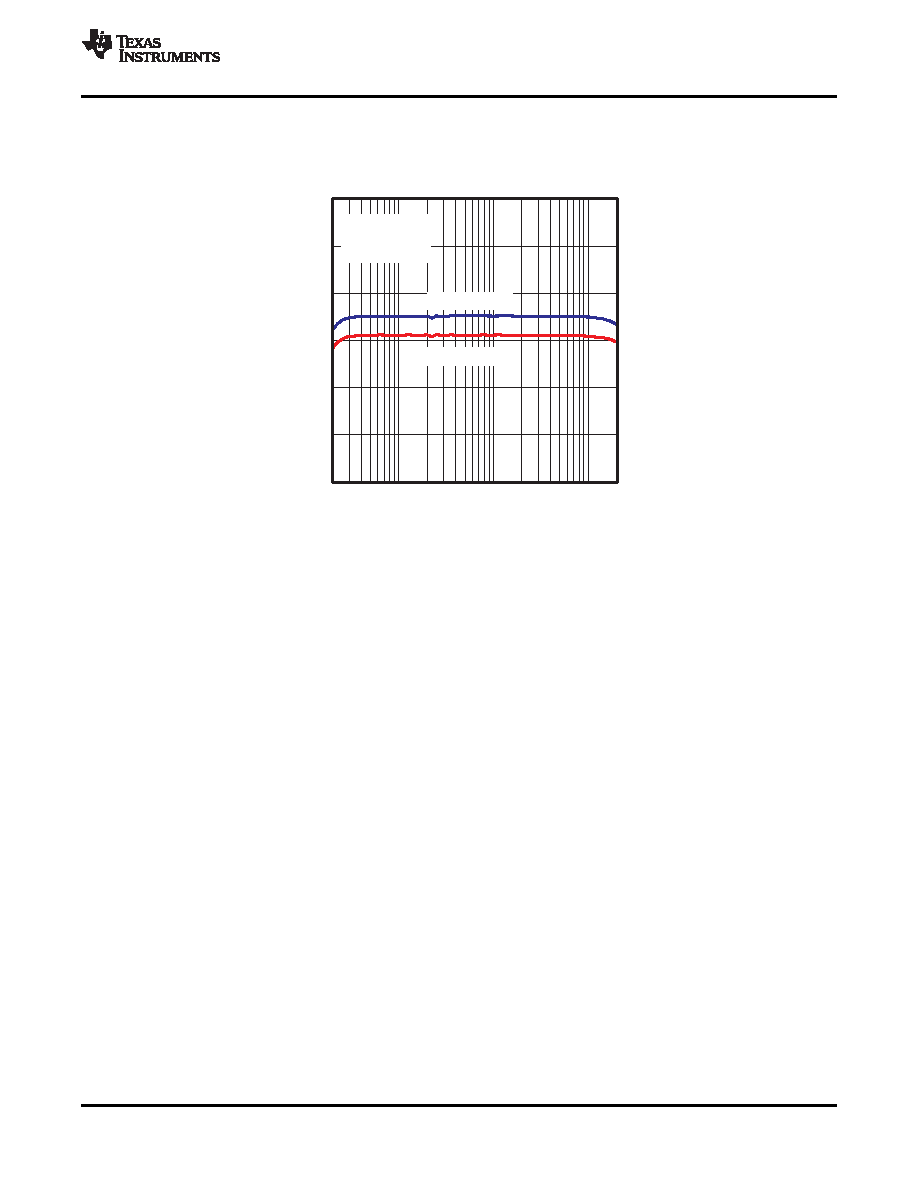- 您現(xiàn)在的位置:買賣IC網(wǎng) > PDF目錄98165 > TAS5710PHP (TEXAS INSTRUMENTS INC) 20.2 W, 2 CHANNEL, AUDIO AMPLIFIER, PQFP48 PDF資料下載
參數(shù)資料
| 型號: | TAS5710PHP |
| 廠商: | TEXAS INSTRUMENTS INC |
| 元件分類: | 音頻/視頻放大 |
| 英文描述: | 20.2 W, 2 CHANNEL, AUDIO AMPLIFIER, PQFP48 |
| 封裝: | 7 X 7 MM, GREEN, PLASTIC, HTQFP-64 |
| 文件頁數(shù): | 7/57頁 |
| 文件大小: | 1124K |
| 代理商: | TAS5710PHP |
第1頁第2頁第3頁第4頁第5頁第6頁當(dāng)前第7頁第8頁第9頁第10頁第11頁第12頁第13頁第14頁第15頁第16頁第17頁第18頁第19頁第20頁第21頁第22頁第23頁第24頁第25頁第26頁第27頁第28頁第29頁第30頁第31頁第32頁第33頁第34頁第35頁第36頁第37頁第38頁第39頁第40頁第41頁第42頁第43頁第44頁第45頁第46頁第47頁第48頁第49頁第50頁第51頁第52頁第53頁第54頁第55頁第56頁第57頁

100
90
80
70
60
50
40
f Frequency Hz
Crosstalk
dB
G015
20
100
1k
10k
20k
Left to Right
Right to Left
PO = 1 W
PVCC = 24 V
RL = 8
DETAILED DESCRIPTION
POWER SUPPLY
www.ti.com............................................................................................................................................................................................... SLOS605 – JANUARY 2009
TYPICAL CHARACTERISTICS, BTL CONFIGURATION (continued)
CROSSTALK
vs
FREQUENCY
Figure 17.
To facilitate system design, the TAS5710 needs only a 3.3-V supply in addition to the 10-V to 26-V power-stage
supply. An internal voltage regulator provides suitable voltage levels for the gate drive circuitry. Additionally, all
circuitry requiring a floating voltage supply, e.g., the high-side gate drive, is accommodated by built-in bootstrap
circuitry requiring only a few external capacitors.
In order to provide good electrical and acoustical characteristics, the PWM signal path for the output stage is
designed as identical, independent half-bridges. For this reason, each half-bridge has separate bootstrap pins
(BST_X), and power-stage supply pins (PVCC_X). The gate drive voltages (VCLAMP_AB and VCLAMP_CD) are
derived from the PVCC voltage. Special attention should be paid to placing all decoupling capacitors as close to
their associated pins as possible. In general, inductance between the power-supply pins and decoupling
capacitors must be avoided.
For a properly functioning bootstrap circuit, a small ceramic capacitor must be connected from each bootstrap pin
(BST_X) to the power-stage output pin (OUT_X). When the power-stage output is low, the bootstrap capacitor is
charged through an internal diode connected between the gate-drive regulator output pin (VCLAMP_X) and the
bootstrap pin. When the power-stage output is high, the bootstrap capacitor potential is shifted above the output
potential and thus provides a suitable voltage supply for the high-side gate driver. In an application with PWM
switching frequencies in the range from 352 kHz to 384 kHz, it is recommended to use 220-nF ceramic
capacitors, size 0603 or 0805, for the bootstrap supply. These 220-nF capacitors ensure sufficient energy
storage, even during minimal PWM duty cycles, to keep the high-side power stage FET (LDMOS) fully turned on
during the remaining part of the PWM cycle.
Special attention should be paid to the power-stage power supply; this includes component selection, PCB
placement, and routing. As indicated, each half-bridge has independent power-stage supply pins (PVCC_X). For
optimal electrical performance, EMI compliance, and system reliability, it is important that each PVCC_X pin is
decoupled with a 100-nF ceramic capacitor placed as close as possible to each supply pin.
The TAS5710 is fully protected against erroneous power-stage turnon due to parasitic gate charging.
Copyright 2009, Texas Instruments Incorporated
15
Product Folder Link(s): TAS5710
相關(guān)PDF資料 |
PDF描述 |
|---|---|
| TAS5715PHPR | 41.5 W, 2 CHANNEL, AUDIO AMPLIFIER, PQFP48 |
| TAS5715PHP | 41.5 W, 2 CHANNEL, AUDIO AMPLIFIER, PQFP48 |
| TAS5716PAPR | 20.6 W, 2 CHANNEL, AUDIO AMPLIFIER, PQFP64 |
| TAS5716PAP | 20.6 W, 2 CHANNEL, AUDIO AMPLIFIER, PQFP64 |
| TAS5719PHPR | 15 W, 2 CHANNEL, AUDIO AMPLIFIER, PQFP48 |
相關(guān)代理商/技術(shù)參數(shù) |
參數(shù)描述 |
|---|---|
| TAS5710PHP | 制造商:Texas Instruments 功能描述:Audio Power Amplifier IC 制造商:Texas Instruments 功能描述:IC, AUDIO PWR AMP, CLASS D, 20W HTQFP-48 |
| TAS5710PHPR | 功能描述:音頻放大器 20W St Closed-loop I2S Audio Amp RoHS:否 制造商:STMicroelectronics 產(chǎn)品:General Purpose Audio Amplifiers 輸出類型:Digital 輸出功率: THD + 噪聲: 工作電源電壓:3.3 V 電源電流: 最大功率耗散: 最大工作溫度: 安裝風(fēng)格:SMD/SMT 封裝 / 箱體:TQFP-64 封裝:Reel |
| TAS5711 | 制造商:TI 制造商全稱:Texas Instruments 功能描述:20-W DIGITAL AUDIO-POWER AMPLIFIER WITH EQ, DRC, AND 2.1 MODE |
| TAS5711PHP | 功能描述:音頻放大器 2-Channel Dig Audio Amp RoHS:否 制造商:STMicroelectronics 產(chǎn)品:General Purpose Audio Amplifiers 輸出類型:Digital 輸出功率: THD + 噪聲: 工作電源電壓:3.3 V 電源電流: 最大功率耗散: 最大工作溫度: 安裝風(fēng)格:SMD/SMT 封裝 / 箱體:TQFP-64 封裝:Reel |
| TAS5711PHP | 制造商:Texas Instruments 功能描述:Audio Power Amplifier IC 制造商:Texas Instruments 功能描述:IC, AUDIO PWR AMP, CLASS D, 20W HTQFP-48 |
發(fā)布緊急采購,3分鐘左右您將得到回復(fù)。